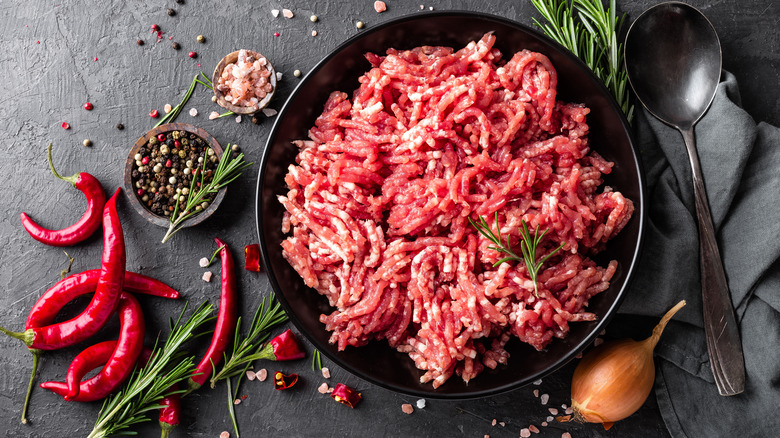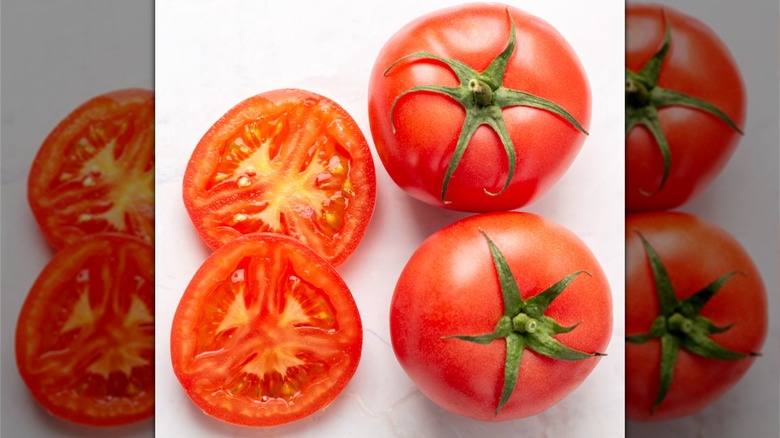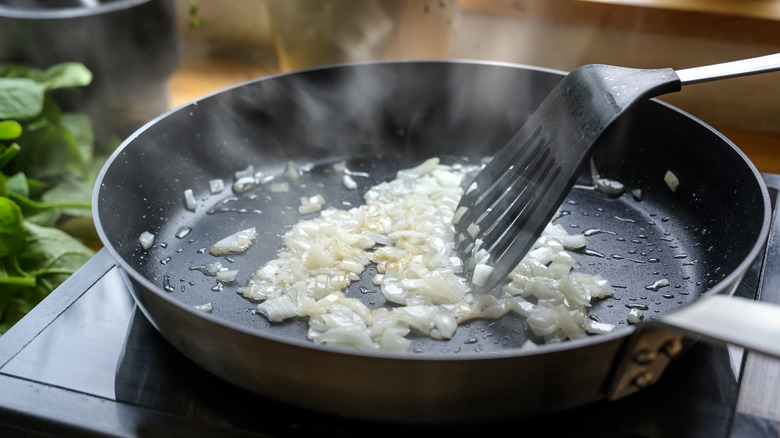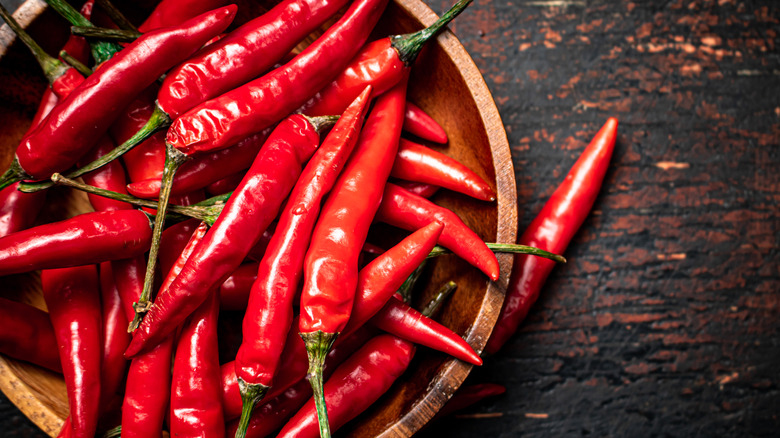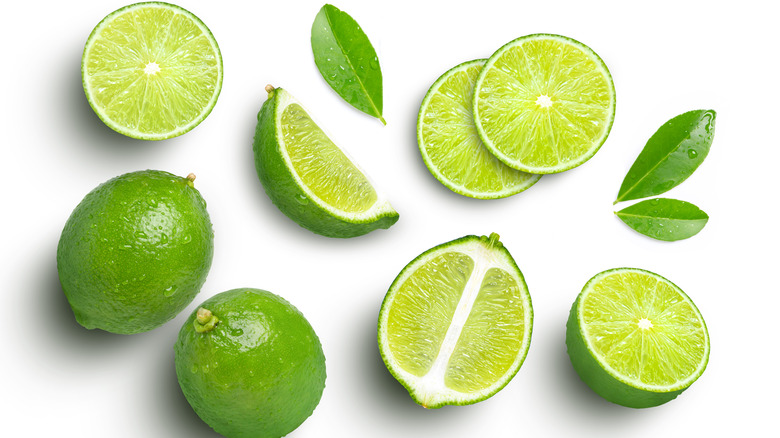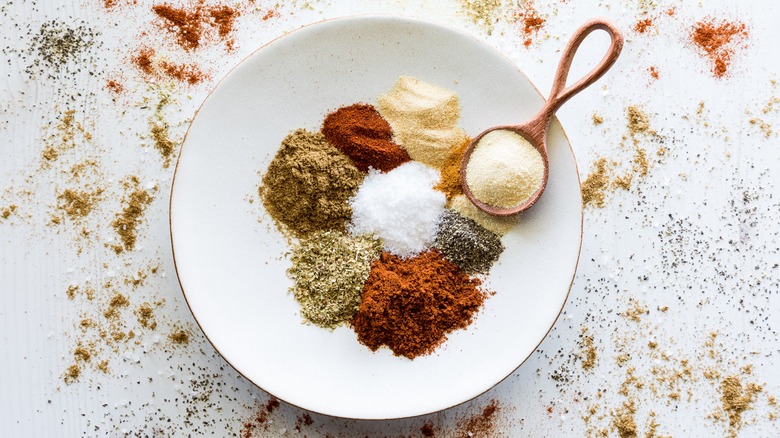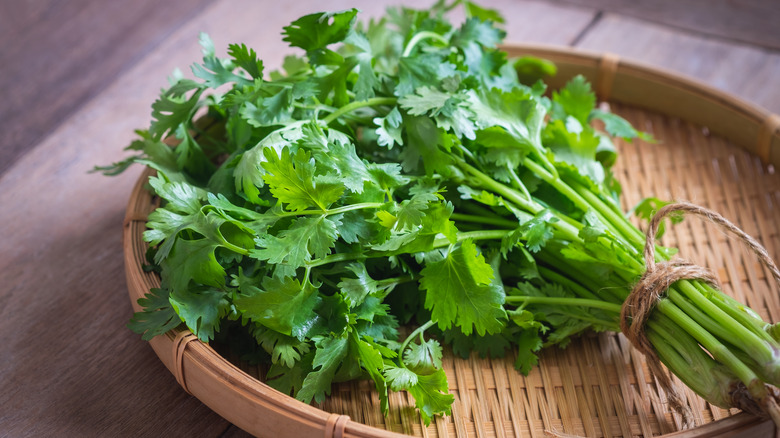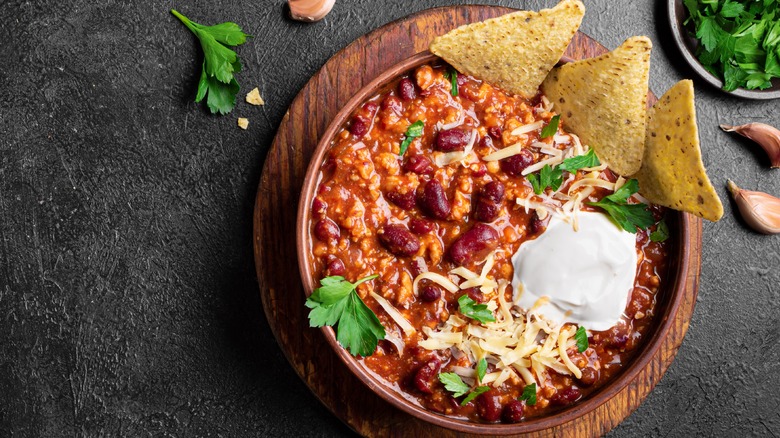14 Ingredients That Will Make Canned Chili Taste Homemade
When you're craving a bowl of piping hot chili but don't have an hour or more to spare for chopping, sautéing, and simmering, canned chili is the next best thing. Luckily, there is no shortage of options, whether you're looking for something spicy and meaty or mild and heavy on the vegetables. There are even options that don't have beans. If you're not sure where to start, we've ranked 11 canned chili brands from worst to best so you don't have to gamble on choosing the right one.
Unfortunately, even the best canned chili comes with that tell-tale canned soup flavor. It's one of those things that is difficult to put your finger on, but which is definitely detectable. When you're hungry and looking for a quick bite to eat or on a camping trip and planning to eat directly out of the can, this artificial taste might not bother you. However, in most other cases, it's worth taking a few extra minutes to mask it in any way possible. Adding an extra ingredient or two will not only enhance the flavor, but give the dish a personal flourish that will make it taste and look homemade. Here are some of the best options.
1. Ground beef or turkey
Even when you're using a can of chili that already has meat, doubling up with freshly cooked beef or turkey will make all the difference. For one thing, it won't disintegrate into the broth the way meat tends to do when it's been sitting in a can for a while. It will have its own distinctive, chewy texture that will set it apart from all the other ingredients. It also provides a fresh, succulent flavor that you can only achieve by browning the meat. Because you have control over how you cook it, you can guarantee that it will have the ideal flavor.
When you cook meat and other foods at temperatures above 310 F, it undergoes the Maillard reaction, a process by which proteins are broken down to produce a toasted taste and fragrance along with brown, crunchy skin. Think of the change that a piece of bread undergoes when it's put in the toaster or how bacon goes from limp and rubbery when raw to crispy and brown when cooked on high heat. The same is true of ground beef and turkey. Browning it and adding it to your canned chili will work wonders on the flavor and bulk it up if you're trying to stretch a single can into a meal for more than one person.
2. Fresh tomatoes
One of the quickest and simplest ways to remove the canned taste from a bowl of chili is to add fresh tomatoes. If it's the peak of summer and those tomatoes come straight out of your garden, all the better, but even a mediocre variety from the supermarket will do the trick. With their slightly acidic, sometimes grassy flavor and juicy texture, fresh tomatoes cannot be duplicated. Canned tomatoes might have a more intense taste and a better texture for making sauces, but fresh tomatoes will mask the processed flavor of the rest of the ingredients like a charm and make you believe you're eating something made freshly that day.
There are several ways to incorporate fresh tomatoes into your chili. You can make it as simple as chopping them up and adding them as a garnish, or mix them into the stew as you heat it. You can also sauté them slightly in butter first until they release their juice and their flavors intensify and sweeten.
3. Sautéed onions and garlic
If there's one cooking directive that professional chefs and casual home cooks alike know like the backs of their hands, it's starting a recipe by sautéing onions and garlic. This simple combination of alliums undergoing the Maillard reaction is the foundation to many a savory masterpiece, be it a simple chicken soup or an elaborate coq au vin. The process yields a heady mixture of sweetness, caramelization, umami, and a hint of heat from the spicy garlic, creating the perfect base for layering other flavors.
Many canned chilis already contain onions and garlic, but adding your own will boost the flavor considerably. Before you begin, it's worth keeping in mind several rules of thumb to avoid inadvertently steaming the onions or overcooking the garlic. If you need to brush up on how to sauté onions like a pro, we have a handy guide that provides step-by-step instructions. The longer you sauté them, the sweeter and more caramelized they will become. Leave at least 20 minutes for the process and avoid overcrowding the slices so you don't end up with a tasteless puddle. Adding salt will help draw out their moisture and speed browning.
When it comes to adding the garlic, wait until about one minute before the onions are finished. Since garlic has much less moisture than onions, it burns faster, and burnt garlic will pervade your food with a bitter flavor — 60 seconds is all it needs.
4. Beer or red wine
Many recipes for beef stew include an alcoholic element, and for good reason. A richly flavored beverage like full-bodied red wine or stout beer adds a unique depth of flavor that can't be missed. Our beer chili recipe is a great example, calling for a can of lager or stout to deglaze the pan once you've sautéed the meat and veggies. If you're adding your own browned meat to the canned chili, this is the best way to incorporate the beer or wine. If you're just planning on adding alcohol and nothing else, make sure to simmer it with the chili for a while. Not only will this ensure that all the flavors are incorporated, but it will also burn off some of the alcohol. No one wants to get tipsy from a bowl of chili.
If you're wondering how long it takes for alcohol to cook out of a dish, you might be surprised to learn that it will never burn off entirely. That is, unless you're willing to wait a good three hours before digging in. To avoid boozy chili, practice moderation. Our beer chili recipe calls for only one 12-ounce can of beer per 10-serving batch. If you're heating up a single can of chili, a small splash will do the trick.
5. Sautéed veggies
One of the elements that is consistently lacking in canned chilis is color. There's the dark red of the tomatoes and chili powder and the brown of the meat, but it's all pretty homogenous, and the veggies, if there are any, are typically more of a token gesture than a main ingredient. But vegetables provide a wide range of flavors, textures, and colors that can elevate just about any savory meal to new heights, not to mention boost its nutritional value. If you're wondering how to turn that colorless (though delicious) sludge into something irresistible, look no further than the produce aisle.
Chili can accommodate all types of vegetables, from creamy potatoes to sweet green peas to carrots and purple cabbage. You can even add handfuls of spinach to pack your meal with vitamins. Sautéing the veggies first to ensure they have a harmonious texture with the chili takes only a few minutes and means they will already be hot when you add them. The only limiting factor is ratios. As healthy and eye-catching as they are, you don't want to accidentally end up with a vegetable stew rather than chili with vegetables.
6. Chili peppers
By definition, chili contains some form of chili peppers. Although the history of this singular stew is hotly disputed, one story is that chili was founded in the Canary Islands, which were under Spanish control in the 1700s. So it was apparently migrants who moved to what's now San Antonio, Texas, that were responsible for creating the thick, spicy, reddish concoction that we now know and love. Their versions regularly contained equal parts meat and peppers, but these days, some chili is so mild that it hardly justifies its name.
Adding fresh peppers to canned chili is an easy way to put some zing into an otherwise lackluster stew. Many grocery stores stock a wide range of pepper varieties, so whether you like to keep things mild or want to incinerate your tastebuds, there's something for everyone. You can opt for red peppers to stick to the red theme of the chili or branch out with green ones for color contrast. Jalapeños are widely available and mild enough to be broadly appealing, while scotch bonnet peppers will burn holes in your tongue. If you're not sure where to start, we have a handy guide to 21 popular types of peppers and how spicy they are that will help you know what to look for.
7. Lime juice
A classic chili recipe contains many elements. There's the rich, savory saltiness of the meat, the starchiness of the beans and vegetables, the slight sweetness of the tomatoes, and the heat of the chili powder. Some versions also have the earthy warmth of other seasonings like cumin and cinnamon. Altogether, these ingredients create an aromatic dish that wants for nothing. However, if you're opting for canned chili, these elements will be less distinct. After stewing amongst themselves for an indefinite period while on the shelf, they will be muted and lacking in pizazz, no matter how many preservatives have gone into them. To re-inject some vitality into the proceedings, all you need is a simple squeeze of lime.
The reason lime goes so well with chili goes beyond aesthetics. Lime juice is highly acidic, and its acidity heightens and brightens the other flavors. Think of it like the volume dial on a car radio, but instead of increasing sound, it increases flavor. Just a single wedge of lime per serving will do the trick.
8. Sour cream and cheese
Call it lazy or just plain reliable — you can't go wrong with garnishing your chili with cheese and sour cream. The cheese part is obvious. Salty, gooey, and full of umami richness, it belongs on pretty much any savory dish. When adding cheese to chili, you can even go the extra mile by having a bag of tortilla chips on hand. Yes, it's still a complete meal, but it will taste deliciously similar to nachos.
Taking things up a notch, sour cream is more than just a topping to give chili a creamy twist. As Tasting Table explains, stirring a dollop or more of it into the mixture will give the chili a tartness that lifts and brightens the other flavors. Its acidity plays a similar function to lime juice, with the added benefit of providing a creamy texture. If you're using a can of chili that lacks flavor and is a bit watery, stirring in some sour cream will fix both problems.
9. Corn
Since the flavors in chili tend to homogenize when left to sit in a can, adding a burst of flavor makes all the difference. Garnishes and sautéed veggies are excellent options, but for a quick fix that will improve every bite of the dish, corn is the answer. Sweet and full of moisture, it adds flavor, texture, and color without requiring much leg work. You probably even have a bag of frozen corn sitting in your freezer.
To incorporate it into your chili, simply follow the cooking instructions on the back of the package, stir it into the heated chili, and enjoy the results. Even canned corn retains most of its fresh flavor, so you can make things even easier for yourself by sticking with only canned ingredients. Once you've added the corn, you'll encounter small, juicy pockets of sweetness in every bite to break up the monotony of the beans, broth, and meat. Add some cilantro for good measure (and extra color) and marvel at how easily that can of chili became a cozy, partially homemade meal.
10. Ground spices
If you're choosing to heat up a can of chili because you're short on time, you won't have the luxury of sautéing your own meat or raiding your produce drawer. This is where ground spices save the day. Any chili worth its salt will already have chili powder in it, but there are plenty of other options that will liven things up without overpowering its central flavor. Our easy beanless chili recipe, for example, calls for smoked paprika, which adds, not surprisingly, a hint of smokiness. Cumin is another popular option, cropping up in chili recipes almost as often as chili powder itself. It provides an earthy, savory warmth that complements the heat of the pepper.
For those who want to try something bold, let us refer you to cinnamon and cocoa powder. As unlikely as it may seem, this combination will deepen the flavors of the meat and broth without conjuring associations with brownies or cinnamon rolls. Our Cincinnati chili recipe even calls for cloves in addition to cinnamon, while our savory no bean chili recipe calls for two teaspoons of cocoa powder.
11. Crushed tortilla chips
If you're a fan of tortilla soup, adding corn chips to your chili will create the best of both worlds. However, there are more benefits to this addition than its ability to bridge the gap between two of your favorite soups. For one thing, it adds salt, the cornerstone of any good bowl of chili. For another, it provides texture. No vegetable can match the crunchiness of a tortilla chip, and the variation will significantly improve a dull can of chili.
A third, more practical reason to add tortilla or corn chips is that they help thicken an otherwise watery consistency. Chili should be as thick and velvety as stew, not thin. Watery broths have their place. When you're eating chicken soup, for example, you want to be able to practically drink the hot, aromatic liquid out of a mug. But chili needs to be dense and meaty, and if you find yourself with a can of watery soup instead of creamy stew, a bag of corn chips will save the day. It is, without question, the best way to thicken up chili. Simply crush them and stir them into the soup where they will absorb the moisture. Problem solved.
12. Canned beans
Adding beans to chili might seem redundant since most canned chilis already contain at least one variety. However, in addition to boosting the fiber and protein content of the dish, you'll be adding another texture. Canned chili often lacks textural variation. After sitting together in the same liquid, the meat, beans, and stewed veggies start to soften into one another, creating a smooth, almost cohesive consistency. This may be part of its appeal to some, but for others, it lacks intrigue. Instead of taking the time to sauté veggies, you can simply add a can of beans. They tend to be less mushy than the beans in chili, giving them more bite and chewiness.
This option also allows you to add different types of beans to your chili. If you buy a product that only uses kidney beans, opt for a can of black beans, pinto beans, or even cannellini beans. Each variety will offer subtle flavor differences and add to the color palette of the dish. Our three-bean chili recipe, for example, calls for a trio of pinto, black, and kidney beans for a colorful medley of flavor.
13. Fresh cilantro
Any time you're serving soup or stew — whether canned or homemade — a garnish is almost always a good idea. For one thing, most garnishes take almost no time to prepare. For another, they add a touch of sophistication. The ideal garnish is both eye-catching and flavorful, such as a sprig of mint on a scoop of vanilla icing or lemon zest on roasted chicken. There are many garnishes that you can pair with chili, but the most common, and dare we say the most harmonious, is cilantro. The parsley lookalike is integral to Mexican cuisine, so it stands to reason that it would taste delicious with spicy Southwestern chili.
Any discussion about cilantro must come with a caveat: it has a controversial flavor. If you're a cilantro lover, adding it to your bowl of canned chili is a no-brainer. With its punchy flavor and bright green hue, it could be the perfect match.
14. Toppings galore
When it comes to toppings, the sky's the limit. You could max out your credit card procuring all the options. Luckily, however, you only need a few of them to completely transform your canned chili and mask any dullness that might be lingering after all that time in a can. There are many approaches you can take. You could opt for color, choosing ingredients like purple cabbage, fresh corn, cilantro, and orange cheddar cheese. You could opt for indulgence, choosing cheese, corn chips, and sour cream. You could even opt for nutrition, smothering your chili with slices of avocado, bell pepper, and fresh herbs.
If you want to make a real impression, Food Republic has compiled a list of chili toppings that are way more adventurous than shredded cheese (though we are all for adding shredded cheese to anything). It includes everything from ranch dressing to sliced radishes, and contains ideas that will resonate with every type of eater.

